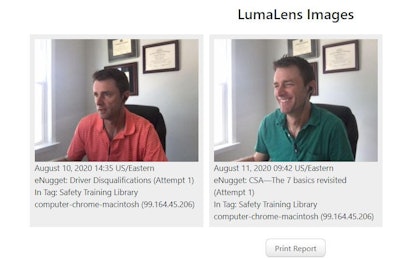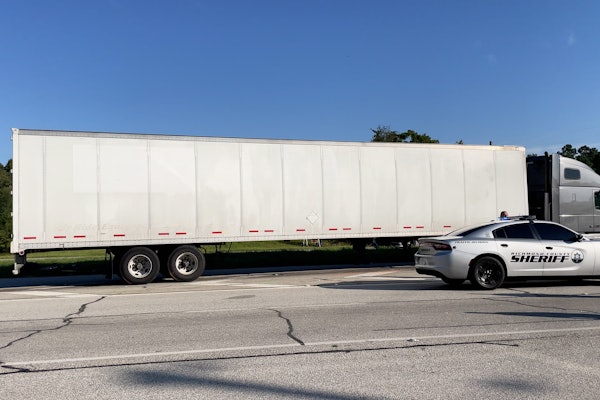“Nuclear” has become a familiar term in the transportation industry to explain rising insurance costs from runaway jury verdicts.
 Online training platforms help carriers document training for legal protection. Image courtesy of CarriersEdge.
Online training platforms help carriers document training for legal protection. Image courtesy of CarriersEdge.One of the most famous nuclear verdicts was handed out in May 2018 by a Texas jury in Blake v. Ali and Werner Enterprises.
On a wintry day in 2014, a vehicle crossed a centerline and crashed into a truck driver, Shiraz Ali, who was going the posted speed limit and staying in his lane. The incident was recorded by dashcam footage.
The plaintiff was awarded $92 million on two counts of negligence. Attorneys have been successful to reach higher jury verdicts in this and other cases by bringing out the Reptile Theory approach.
“With this approach, the counsel tries to paint defendant motor carriers, among other things, as failing to take reasonable steps to train drivers,” said J.W. Taylor, owner of Taylor & Associates, a transportation-focused law firm based in Winter Haven, Florida.
In Blake v. Ali and Werner Enterprises, the plaintiff’s attorneys argued the truck driver should have been driving slower given the weather, and convinced the jury that the carrier failed to properly train the driver on procedures for handling icy conditions.
A review of court documents for this and other cases shows how attorneys try to drive a wedge between the driver and company by asking the driver whether he or she knew about a certain rule or regulation — and what the company did to enforce it.
“Properly documenting training and continuing education can be helpful in combating these tactics,” Taylor said.
Closing the gap
As part of the Reptile Theory approach, a plaintiff attorney will question a truck driver in an attempt to get the driver to claim ignorance of certain regulations or training they have received.
The purpose is to raise concerns “about whether or not we have in fact trained or provided guidance to our employee sufficient to comply with the regulation,” said Steve Setliff, owner and managing partner of Setliff Law, a firm that provides legal defense for transportation companies.
 Fleetworthy Solutions has a web portal its clients use to track their compliance.
Fleetworthy Solutions has a web portal its clients use to track their compliance.Billy Stover, DOT regulatory compliance consultant for Fleetworthy Solutions, encourages carriers to use in-house training coupled with online training for safety and compliance. Fleetworthy provides audits and recommendations to improve training and documentation.
“When we work with carriers, we come up with a ‘plan to protect,’ ” he said. “We start with a DOT boot camp, and it’s a combination of in-house training and online training. We work with CarriersEdge, which has a great library of online courses — many that support our DOT training.”
Tim Brewster, director of loss prevention and recovery for National Interstate Insurance Company, stresses the importance of fleets having checkpoints for driver training, regardless of job experience. Those checkpoints should include orientation and recurrent and remedial training.
“Ongoing training should take place multiple times throughout the year with knowledge checks to ensure drivers understand and can retain the information,” Brewster said.
Besides documenting training, online learning programs can assist with retention of information. If a driver struggles with any part of the test, retraining can be done to help the driver.
Retaining information
Online driver training platforms, or learning management systems (LMS), have built-in assessment tools to document driver awareness of rules and regulations.
Rather than give drivers a quiz at the end — and then give them the option to continue guessing until they score 100 — the approach used by Instructional Technologies Inc. (ITI) for its Pro-Tread courses requires the driver to answer questions throughout the course before they can proceed.
 Aaron Purvis, CTO of Instructional Technologies, Inc., says the company responds to one or two subpoenas a month for training records.
Aaron Purvis, CTO of Instructional Technologies, Inc., says the company responds to one or two subpoenas a month for training records.As an added layer of training, Payne Trucking sends periodic “safety flashes” to educate drivers and document their awareness when management sees incident or accident trends developing.
The Fredericksburg, Virginia-based company operates a fleet of more than 130 tractors and 800 end dump trailers, dry vans and storage containers with a service network that covers the Midwest and Eastern states from Florida into Canada.
Payne Trucking uses the Luma eNugget LMS that comes with a collection of more than 500 courses on various orientation, safety and compliance topics in mixed mediums.
“Not only am I getting proof that drivers have received [the training] and completed it, but more importantly from the liability side, there is a realized level of comprehension, and that is priceless,” said Chris Haney, Payne’s director of health, safety, security, environment (HSSE) and human resources.
J.J. Keller’s Safe & Smart Driver Training program uses smaller chunks of online learning with multimedia and learner involvement to drive engagement and retention. A quiz is included after each module, said Steve Murray, vice president of content and consulting services.
The company soon will be able to provide tracking of how each learner answered each question, and training coordinators can use this to focus on areas of lower comprehension, Murray said.
Training authentication
During court cases, plaintiff attorneys typically will ask for evidence of any training that a driver received, or did not receive, that is relevant to the type of accident event.
ITI receives and responds to one or two subpoenas a month from attorneys. The company provides validation of the driver training records, said Aaron Purvis, chief technology officer. Fleets cannot change or adjust driver training records in its web-based Sentix LMS unless drivers actually took the course.
 Luma’s new LumaLens feature captures time-stamped pictures of drivers completing online training to provide a more foolproof method of authentication.
Luma’s new LumaLens feature captures time-stamped pictures of drivers completing online training to provide a more foolproof method of authentication.As an officer of ITI, Purvis said he is the only person with the authorization to make changes to training records, but “that’s not going to happen.” ITI keeps an archive to provide the exact content that drivers received at the time they took the course.
Likewise, Murray said J.J. Keller archives all versions of its training content with the dates, drivers’ scores and their completion status.
“If a client company of ours goes to court, we can easily provide documentation of the content a learner experienced, as well as show that he or she consumed the content and passed the related exams, demonstrating proficiency,” he said.
Instructional design and learning company Luma “Brighter Learning” recently released a new camera-based authentication process for online training. Its new LumaLens process uses an automated method to photo-capture training events.
When a driver logs into the LMS to complete orientation or remedial training assignments, a pop-up screen notifies the user that the device will take periodic pictures during the assessment portion of the training.
Training is a core part of fleet operations, and using technology to authenticate and document these events can be just as important. Online training platforms can give fleets this added layer of protection.











